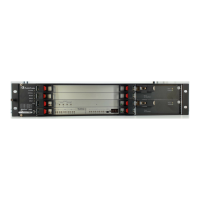Version 7.0 443 Mediant 3000
User's Manual 22. Digital PSTN
22.6 Tunneling Applications
This section discusses the device's support for VoIP tunneling applications.
22.6.1 TDM Tunneling
The device's TDM Tunneling feature allows you to tunnel groups of digital trunk spans or
timeslots (B-channels) over the IP network. TDM Tunneling utilizes the device's internal
routing (without Proxy control) capabilities to receive voice and data streams from TDM
spans or individual timeslots, convert them into packets, and then transmit them over the IP
network (using point-to-point or point-to-multipoint device distributions). A device opposite it
(or several devices when point-to-multipoint distribution is used) converts the IP packets
back into TDM traffic. Each timeslot can be targeted to any other timeslot within a trunk in
the opposite device.
When TDM Tunneling is enabled (the parameter EnableTDMoverIP is set to '1') on the
originating device, the originating device automatically initiates SIP calls from all enabled
B-channels belonging to the spans that are configured with the protocol type ‘Transparent’
(for ISDN trunks) or ‘Raw CAS’ (for CAS trunks). The called number of each call is the
internal phone number of the B-channel from where the call originates. The IP to Trunk
Group Routing table is used to define the destination IP address of the terminating device.
The terminating device automatically answers these calls if the protocol type is set to
‘Transparent’ (ProtocolType = 5) or ‘Raw CAS’ (ProtocolType = 3 for T1 and 9 for E1) and
the parameter ChannelSelectMode is set to 0 (By Dest Phone Number).
Note: It's possible to configure both devices to also operate in symmetric mode. To
do so, set EnableTDMOverIP to 1 and configure the Tel-to-IP Routing table in both
devices. In this mode, each device (after it's reset) initiates calls to the second device.
The first call for each B-channel is answered by the second device.
The device continuously monitors the established connections. If for some reason, one or
more calls are released, the device automatically re-establishes these ‘broken’
connections. When a failure in a physical trunk or in the IP network occurs, the device re-
establishes the tunneling connections when the network is restored.
Note: It's recommended to use the keep-alive mechanism for each connection, by
activating the ‘session expires’ timeout and using Re-INVITE messages.
The device supports the configuration (TDMoIPInitiateInviteTime and
TDMoIPInviteRetryTime parameters) of the following timers for the TDM-over-IP tunneling
application:
Time between successive INVITEs sent from the same trunk.
Time between call release and the new INVITE that is sent on the same channel. The
call can be released if the device receives a 4xx or 5xx response.
By utilizing the ‘Profiles’ mechanism (see ''Coders and Profiles'' on page 381), you can
configure the TDM Tunneling feature to choose different settings based on a timeslot or
groups of timeslots. For example, you can use low-bit-rate vocoders to transport voice and
‘Transparent’ coder to transport data (e.g., for D-channel). You can also use Profiles to
assign ToS (for DiffServ) per source - a timeslot carrying data or signaling is assigned a
higher priority value than a timeslot carrying voice.

